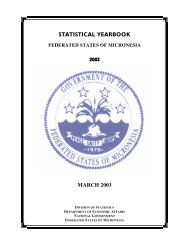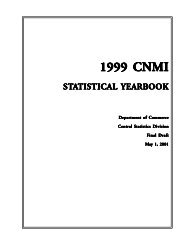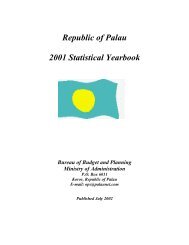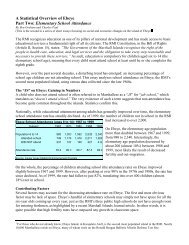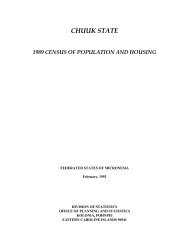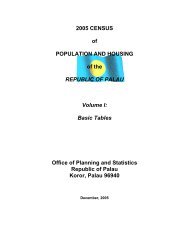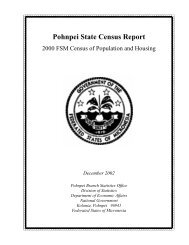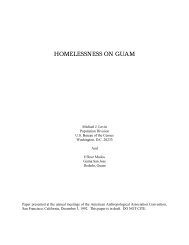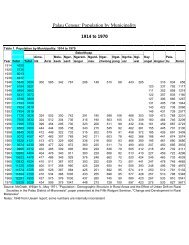Chuuk State Census Report - pacificweb.org
Chuuk State Census Report - pacificweb.org
Chuuk State Census Report - pacificweb.org
Create successful ePaper yourself
Turn your PDF publications into a flip-book with our unique Google optimized e-Paper software.
Chapter 9. Economic Activity2000 FSM <strong>Census</strong> of <strong>Chuuk</strong> <strong>State</strong>Other Labor Force CharacteristicsCommutingMost people in <strong>Chuuk</strong> <strong>State</strong> worked in the same municipality as where they lived; however the majority did not workin the same village. Table 9.19 presents location of work for the regions in the Lagoon only because in the OuterIslands, the islands are too small and there is a limited means of transportation other than walking. In 1994 and 2000,the Southern Namoneas region had the fewest persons working in the same municipality and the fewest people workingin the same village, while Northern Namoneas had the largest portion of persons working in the same village andmunicipality.Table 9.19: Location of Work Last Week by Region, <strong>Chuuk</strong> <strong>State</strong>: 1994 and 20001994 2000Total in formal Percent work in Percent work in Percent work in Total in formal Percent work in Percent work in Percent work inRegion work force same municipality same village different village work force same municipality same village different villageTotal 4,540 85.9 47.8 14.1 4546 82.8 37.6 45.1N. Namoneas 3,067 94.2 48.7 5.8 2204 96.6 38.3 58.3S. Namoneas 860 60.8 29.1 39.2 739 41.7 19.2 22.5Faichuk 613 79.6 62.7 20.4 607 71.7 49.9 21.7Source: 1994 FSM <strong>Census</strong>, Table B15; 2000 FSM <strong>Census</strong>, Table B15A.Armed ForcesOnly 72 persons claimed to be on active duty during the 2000 <strong>Census</strong> and 37 persons were previously on duty in theU.S. Armed Forces. Many of those persons on active duty were U.S. citizens from the Civil Actions Teamsassigned in the FSM. The number of armed forces dependents was 67.ConclusionFor both census years, <strong>Chuuk</strong> <strong>State</strong> had the highest unemployment rate in the FSM, ranging from about 20 percentin 1994 to 34 percent in 2000. Unemployment rate increased as more people were actively looking for andavailable to take a job, plus those who were not actively seeking a job the week before the census but were nowavailable to take a job. Moreover, the labor force participation rate increased from about 38 percent to almost 58percent between 1994 and 2000.The proportion of unemployed persons with no previous work experience was very high, more than 89 percent in1994 and almost 96 percent in 2000. The high proportion for both years suggests that unemployment is a long-termdifficulty for many persons in the state of <strong>Chuuk</strong>. As evident within FSM and elsewhere, persons with highereducation are more likely to be employed and in the labor force than those with little or no schooling, and the femaleunemployment rates are usually more than twice those of males.Subsistence activities were common in <strong>Chuuk</strong> <strong>State</strong> to a certain extent. About 11 percent in 1994 and 16 percent in2000 of the working age population were engaged mostly in farming and fishing for their own use. The Lagoon areahad fewer persons in subsistence activities as compared to the Outer Islands, where subsistence activities are theprimary way of life. The substantial differences among the regions suggest the need for independent planning for theLagoon and the Outer Island regions. About 53 percent in 1994 and almost 65 percent in 2000 of the subsistenceworkers said they could have taken a formal job if it was offered, suggesting that these people were working at lowercapacities than they would prefer.88 <strong>Chuuk</strong> Branch Statistics Office, Division of Statistics, FSM Department of Economic Affairs



